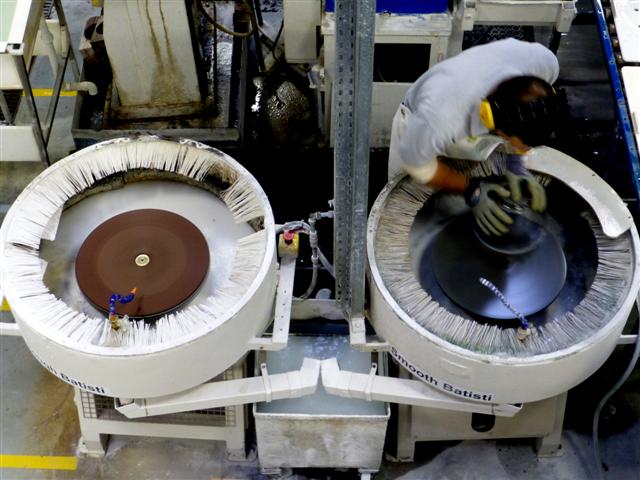So lassen Sie Ihr Glas einen Ceroxid-Latte „trinken“ und kommen klarer, strahlender und bereit für das Rampenlicht heraus.

CeO₂ ist der „Polier-Barista“ der Glaswelt: Seine Partikel schleifen nicht nur – an der Glas-Schlamm-Grenzfläche treten sie in Redox- und Ionenaustausch mit Kieselsäure auf. Dadurch werden Kratzer gemildert und Spitzen abgeschert, sodass eine dichte, optisch glatte Oberfläche entsteht. Deshalb hat CeO₂ in vielen Glasanwendungen Eisenoxid und Zirkonoxid ersetzt und ist nach wie vor die erste Wahl für Teile, bei denen es auf Klarheit ankommt.
Ein Rotationstrommel-Tumbler erzeugt einen kontrollierten „Erdrutsch“ von Medien und Teilen. Für Glas bedeutet das einen gleichmäßigen, spannungsarmen Kontakt über komplexe Formen (Flaschen, Linsen, Ornamente), einen hohen Chargendurchsatz und Wiederholbarkeit – vorausgesetzt, die Parameter sind auf polieren anstatt aggressiver Schnitt.


| Parameter | Empfohlener Ausgangspunkt | Warum es wichtig ist |
|---|---|---|
| Medien | Porzellan (Polierqualität) oder weiche Harz-/Kegelformen; optionale Filzeinsätze für den letzten Durchgang | Minimiert Kratzer und transportiert Schlamm gleichmäßig |
| Medien: Teile | 3:1–5:1 nach Volumen | Verhindert Kollisionen zwischen Teilen und stabilisiert den Fluss |
| Füllstand | 45–55 % des Fassvolumens | Stabile „Lawine“ ohne tote Zonen |
| Laufgeschwindigkeit | ~20–35 U/min (größenabhängig) | Niedrigere Geschwindigkeiten = sanftere Aktion; zu schnell kann Kanten verletzen |
| Gülle | CeO₂ 1–3 Gew.-% in deionisiertem Wasser; pH 6,5–8,0 | Gleicht chemische Unterstützung mit geringer Kratzfestigkeit aus; neutraler pH-Wert für Glasschutz |
| Zusatzstoffe | Geringe Dosis nichtionisches Netzmittel / Antischaummittel | Verbessert die Deckkraft; verhindert Lufteinschlüsse |
| Bühnenzeit | Vorpolitur 30–60 Min. → Endpolitur 30–90 Min. | Abstimmung durch Ra/Rq-Abfall- und Trübungsmessungen |
| Spülen | Gründliche DI-Spülung + neutrales Reinigungsmittel | Entfernt Feinstaub und verhindert so Schleifspuren |
Quantifizieren Sie die Klarheit für Architektur- und allgemeines Glas mit Lichtdurchlässigkeit T vis unter ISO 9050 (oder EN 410). Kombinieren Sie dies mit optischen Trübungs- oder Streuprüfungen. Für Präzisionsoptiken fügen Sie Kratz- oder interferometrische Rauheit (Rq) hinzu, um zu beweisen, dass die polierte „Haut“ wirklich glatter und nicht nur heller ist.
| Symptom | Wahrscheinliche Ursache | Sofortige Lösung |
|---|---|---|
| Dunst fällt langsam ab | CeO₂ zu verdünnt; Medium verglast; Geschwindigkeit zu niedrig | Erhöhen Sie CeO₂ auf 2–3 Gew.-%; Konditionierungs-/Auffrischungsmedium; +3–5 U/min |
| Vereinzelte feine Kratzer | Verunreinigungen; eckige Medien; pH-Drift | Schlamm filtern und Fass spülen; auf Porzellan/Filz umstellen; pH-Wert bei ~7 halten |
| Kantenbeschädigungen/Absplitterungen | Zylinder zu schnell; Medien-Teile-Verhältnis zu niedrig | Reduzieren Sie die Drehzahl; erhöhen Sie das Medienverhältnis auf ≥3:1 |
| Milchiger Film nach dem Trocknen | Reste von Feinstaub oder Hartwassersalzen | Verbessern Sie die DI-Spülung; fügen Sie abschließende Isopropanol-Verdrängungsspülung hinzu |
Unser rotierende Trommelvibratoren sorgen für die stabile Mechanik, während Veredelungsmassen (einschließlich Cerformulierungen) liefern die Chemie. Gemeinsam verwandeln sie mikroraues Glas mit wiederholbarer Effizienz in Produktionsqualität in hochklare Oberflächen.
Email : info@surface-polish.com